When we hold our record-breaking Schmidt Family Reunion in Spencer, Iowa next summer, from July 30-31, 2016, all of the invitees will be descendants of Hans Heinrich Schmidt and Barbara (Rimbach) Schmidt. But just who is this ancestor of ours named Hans Heinrich Schmidt?
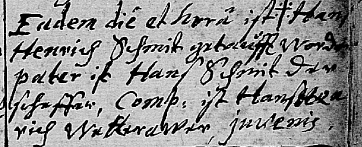 Hans Heinrich Schmidt baptism record, 8 December 1656, Blankenbach
Hans Heinrich Schmidt baptism record, 8 December 1656, Blankenbach
Hans Heinrich Schmidt was born in December of 1656 in the village of Blankenbach, located in the Werra Meissner district of northeast Hesse. His father was a thrice-married (and twice widowed) shepherd and cooper named Hans Schmidt (1594-1680), a native of Nentershausen, Germany, who was 62 years old at the time of Hans Heinrich’s birth. Hans Heinrich’s mother was Barbara (Engeling) Schmidt (1618-1687), a 38-year-old native of Blankenbach, Germany. Hans Heinrich Schmidt was christened in the Evangelisch church of Blankenbach on 8 December 1656. He was named after his baptism sponsor, a young man and friend of the family named Hans Heinrich Wetterau. Hans Heinrich Schmidt had several much older siblings from his father’s first and second marriages. The sibling closest in age to him was his older half-brother, Martin Schmidt (1645-1711), the sole offspring of Hans Schmidt and second wife Catharina (Dietz) Schmidt. Martin was 11 years older than Hans Heinrich. Martin went out and started his own family very young (in 1662, around Martin’s 17th birthday, when Hans Heinrich was only 5 and 1/2 years old), so Hans Heinrich Schmidt must have felt very much like an only child. Hans Heinrich Schmidt was confirmed in the church at Blankenbach on 3 April 1670, when he was 13 years old.
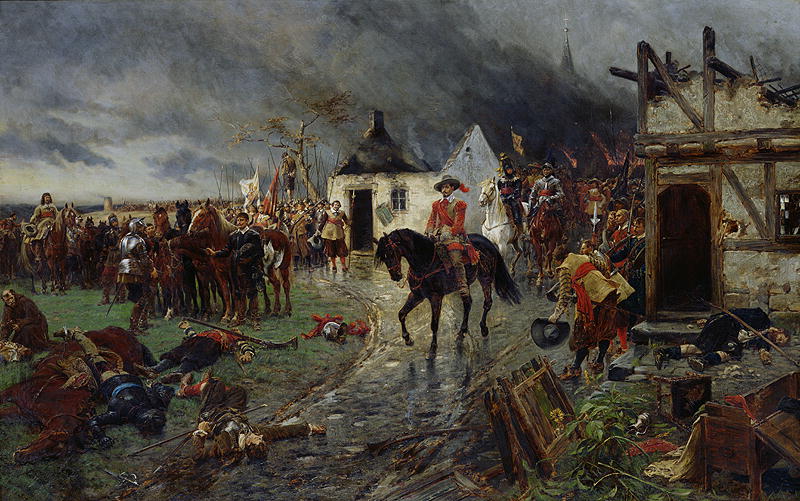 “Wallenstein: A Scene of the Thirty Years’ War,” by Ernest Crofts (Wikimedia Commons)
“Wallenstein: A Scene of the Thirty Years’ War,” by Ernest Crofts (Wikimedia Commons)
Hans Heinrich was born into the devastated aftermath of the Thirty Years’ War, the most brutal and destructive conflict that would befall Europe until World War 1, nearly three centuries later. Protestant and Catholic armies had swept across Hesse several times, plundering everything they could get their hands on, and senselessly killing soldiers and civilians alike. Farms had been ruined, leaving people hungry. Demolished homes had left people exposed to the elements and, combined with the rotting carcasses everywhere and lack of nutrition, sickness and death had been widespread. Hans Heinrich Schmidt would have grown up in a meager and impoverished household, where unending hard work would have been a necessity just to survive.
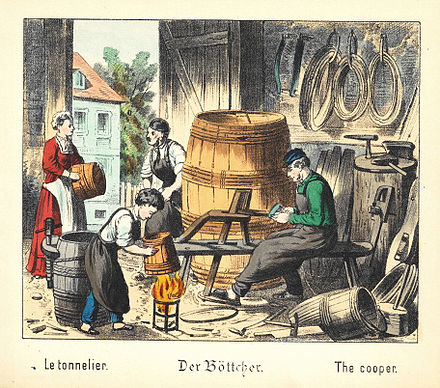 Der Böttcher (from the book “Was willst du werden,” published 1880)
Der Böttcher (from the book “Was willst du werden,” published 1880)
As a young man, in addition to the farming responsibilities that would have been part of living on a sheep farm, Hans Heinrich Schmidt learned the trade of the Böttner/Böttcher (cooper). Things that Hans Heinrich would have probably crafted include: barrels, buckets, tubs, butter churns, casks, pipes, pins, and breakers, among other types of wooden vessels.
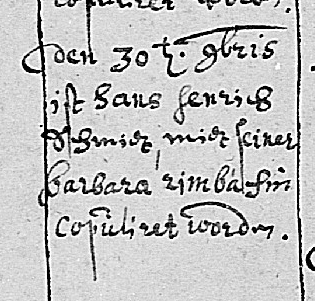 Hans Heinrich Schmidt and Barbara Rimbach marriage record,
Hans Heinrich Schmidt and Barbara Rimbach marriage record,
30 September 1682, Blankenbach
When Hans Heinrich was 25 years old, he married a young lady from Blankenbach named Barbara Rimbach (1661-1738), the daughter of Caspar Rimbach (1620-1696) and Elisabeth (Leinhose) Rimbach (1634-1694), in what would undoubtedly have been an arranged marriage between the Schmidt and Rimbach families. The Schmidt and Rimbach families seemed to have had a close relationship, as Hans Heinrich Schmidt’s future bride, Barbara Rimbach, was actually named after Hans Heinrich’s mother, Barbara (Engeling) Schmidt, who was Barbara Rimbach’s baptism sponsor. Barbara Rimbach was 21 years old at the time of her marriage to Hans Heinrich. Hans Heinrich Schmidt and Barbara Rimbach would go on to have at least six children together: Johannes Schmidt (1683), Hans Heinrich Schmidt II (1686), Johann George Schmidt (1688), Anna (Schmidt) Raub (1690), Martin Schmidt (1693), and Michael Schmidt (1705).
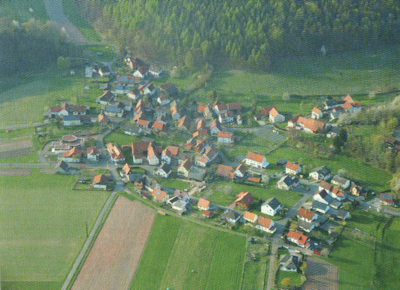 Machtlos, now a borough of Ronshausen
Machtlos, now a borough of Ronshausen
(Image Source: Mueller, Heinrich Georg. 950 Jahre Ronshausen Leben in Unserem Dorf; Gestern, Heute, Morgen; Festschrift Anlasslich Der Jubilaumsfeierlichkeiten Im Jahr 2011. Ronshausen: Vereinsgemeinschaft 950 Jahre Ronshausen, 2011. p.274.)
Between the birth of their son Martin in 1693, and the birth of their son Michael in 1705, when Hans Heinrich Schmidt would have been approximately 40 years old, he moved his family from the city of Blankenbach to the tiny nearby forest village of Machtlos. At the time, Machtlos only had about a dozen households. Being the responsible and industrious man that he was, Hans Heinrich Schmidt soon found himself on the Machtlos village council, or “Gericht”. He would then find himself appointed the village council head–the “Gerichtsschulzen”–a sort of mayor.
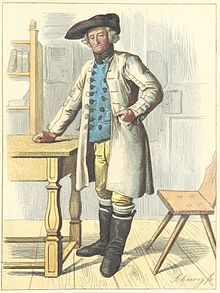 An 1847 painting of a “Schultheiß,” or village mayor (Wikimedia Commons)
An 1847 painting of a “Schultheiß,” or village mayor (Wikimedia Commons)
As the Schulzen, Hans Heinrich would have led the council meetings and supervised other town officials. According to the book “Our Daily Bread: German Village Life, 1500-1850” by Teva J. Scheer (p.77-78), Hans Heinrich Schmidt also likely would have been in charge of the local school and village church administration, collected taxes and fees, ensured that houses were in good repair, verified that food and drink being sold were of good quality and proper weight, and he would have been a mediator between the serfs who lived in the village and their ruling lords (the von Baumbach noble family of nearby Nentershausen).
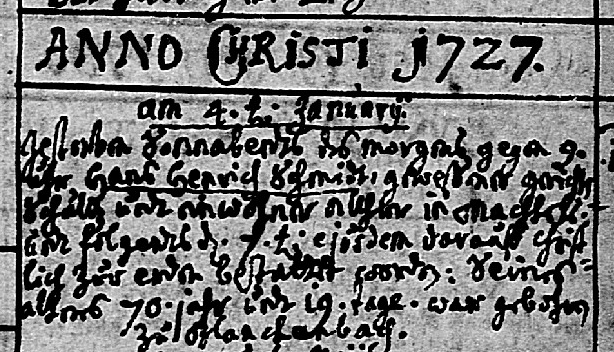 Hans Heinrich Schmidt death & burial record, 4 Jan 1727, Machtlos
Hans Heinrich Schmidt death & burial record, 4 Jan 1727, Machtlos
After spending close to three decades in the hamlet of Machtlos, Hans Heinrich Schmidt died there on the cold winter day of January 4th, 1727, at the age of 70. He was buried in the village church cemetery. His widow, Barbara, lived on for a little over a decade more, passing away on September 28th, 1738 in Machtlos.
Hans Heinrich Schmidt left behind countless grandchildren, who went on to have their own grandchildren, and so on. All in all, Hans Heinrich Schmidt and Barbara (Rimbach) Schmidt gave rise to over a dozen known branches of immigrant families who came to the United States. Over 10,000 individuals in America can trace their lineage to Hans Heinrich Schmidt and Barbara (Rimbach) Schmidt. We are all reuniting for the first time in four centuries, at the Clay County Fairgrounds in Spencer, Iowa on July 30-31, 2016. Be there!
